Management Accounting Report for EverJoy Enterprises (UK)
VerifiedAdded on 2021/01/02
|32
|5866
|208
Report
AI Summary
This report serves as a comprehensive management accounting analysis for EverJoy Enterprises, a UK-based leisure and entertainment company. It delves into the core concepts of management accounting, differentiating it from financial accounting and exploring various cost accounting systems, including direct costs and standard costing. The report examines inventory management systems, job costing systems, and different types of management accounting reports. It also includes a numerical problem-solving section that calculates the break-even point and profit projections for a concert event, offering insights into profitability. Furthermore, the report evaluates the role of budgeting as a planning and problem-solving tool, and assesses the importance of strong financial governance in preventing financial issues, offering recommendations for sustainable success. The report includes references and appendices to support its findings and recommendations, providing valuable information for EverJoy Enterprises.
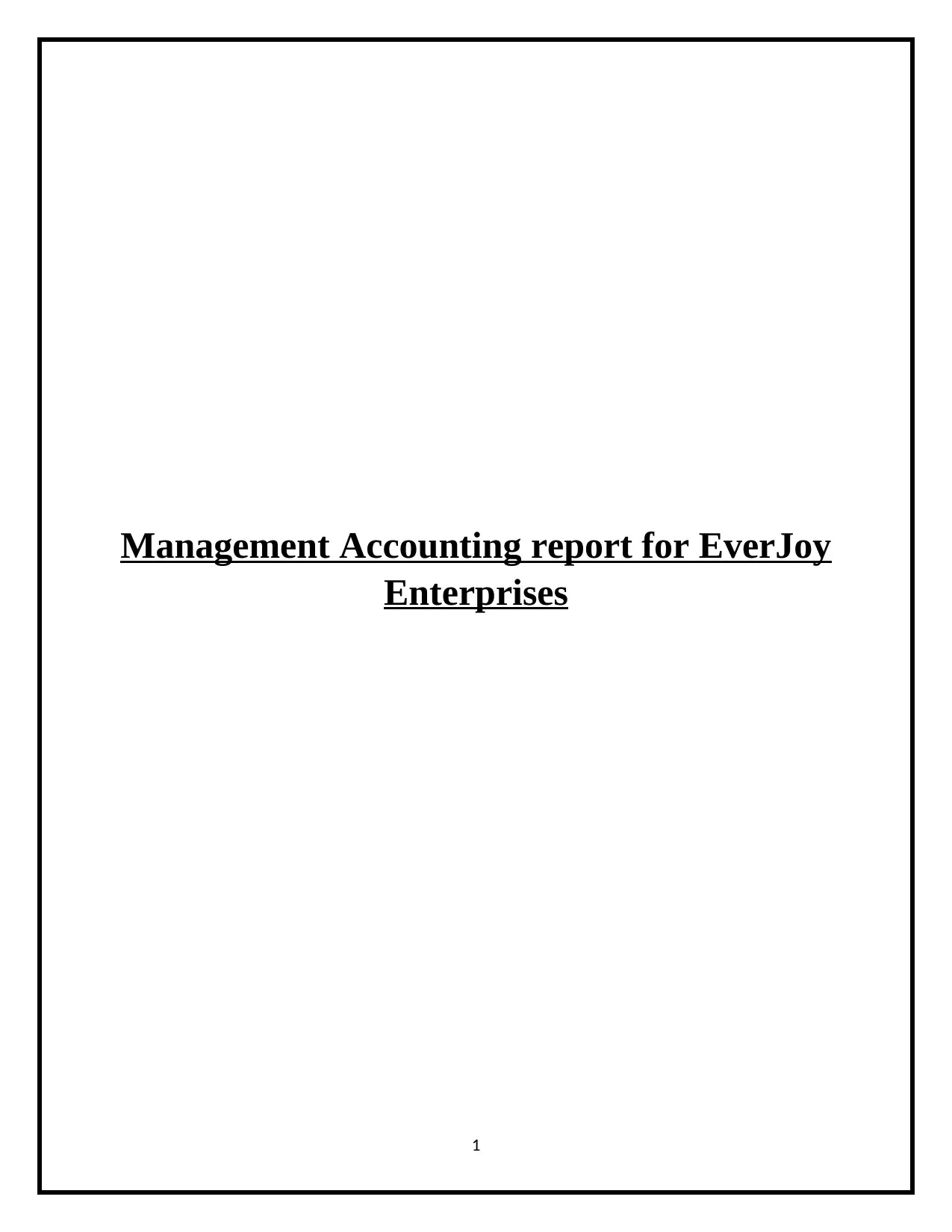
Management Accounting report for EverJoy
Enterprises
1
Enterprises
1
Paraphrase This Document
Need a fresh take? Get an instant paraphrase of this document with our AI Paraphraser
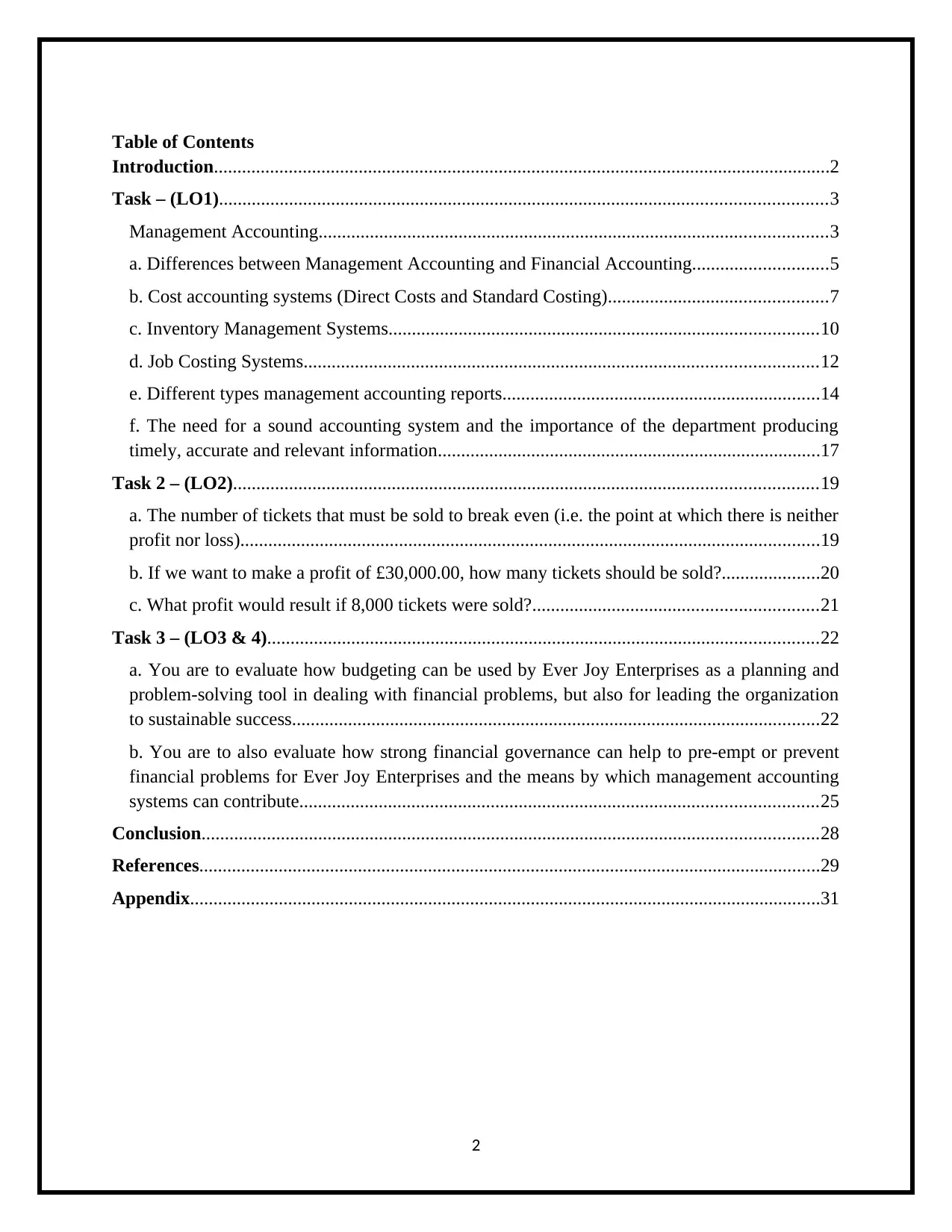
Table of Contents
Introduction....................................................................................................................................2
Task – (LO1)..................................................................................................................................3
Management Accounting.............................................................................................................3
a. Differences between Management Accounting and Financial Accounting.............................5
b. Cost accounting systems (Direct Costs and Standard Costing)...............................................7
c. Inventory Management Systems............................................................................................10
d. Job Costing Systems..............................................................................................................12
e. Different types management accounting reports....................................................................14
f. The need for a sound accounting system and the importance of the department producing
timely, accurate and relevant information..................................................................................17
Task 2 – (LO2).............................................................................................................................19
a. The number of tickets that must be sold to break even (i.e. the point at which there is neither
profit nor loss)............................................................................................................................19
b. If we want to make a profit of £30,000.00, how many tickets should be sold?.....................20
c. What profit would result if 8,000 tickets were sold?.............................................................21
Task 3 – (LO3 & 4)......................................................................................................................22
a. You are to evaluate how budgeting can be used by Ever Joy Enterprises as a planning and
problem-solving tool in dealing with financial problems, but also for leading the organization
to sustainable success.................................................................................................................22
b. You are to also evaluate how strong financial governance can help to pre-empt or prevent
financial problems for Ever Joy Enterprises and the means by which management accounting
systems can contribute...............................................................................................................25
Conclusion....................................................................................................................................28
References.....................................................................................................................................29
Appendix.......................................................................................................................................31
2
Introduction....................................................................................................................................2
Task – (LO1)..................................................................................................................................3
Management Accounting.............................................................................................................3
a. Differences between Management Accounting and Financial Accounting.............................5
b. Cost accounting systems (Direct Costs and Standard Costing)...............................................7
c. Inventory Management Systems............................................................................................10
d. Job Costing Systems..............................................................................................................12
e. Different types management accounting reports....................................................................14
f. The need for a sound accounting system and the importance of the department producing
timely, accurate and relevant information..................................................................................17
Task 2 – (LO2).............................................................................................................................19
a. The number of tickets that must be sold to break even (i.e. the point at which there is neither
profit nor loss)............................................................................................................................19
b. If we want to make a profit of £30,000.00, how many tickets should be sold?.....................20
c. What profit would result if 8,000 tickets were sold?.............................................................21
Task 3 – (LO3 & 4)......................................................................................................................22
a. You are to evaluate how budgeting can be used by Ever Joy Enterprises as a planning and
problem-solving tool in dealing with financial problems, but also for leading the organization
to sustainable success.................................................................................................................22
b. You are to also evaluate how strong financial governance can help to pre-empt or prevent
financial problems for Ever Joy Enterprises and the means by which management accounting
systems can contribute...............................................................................................................25
Conclusion....................................................................................................................................28
References.....................................................................................................................................29
Appendix.......................................................................................................................................31
2
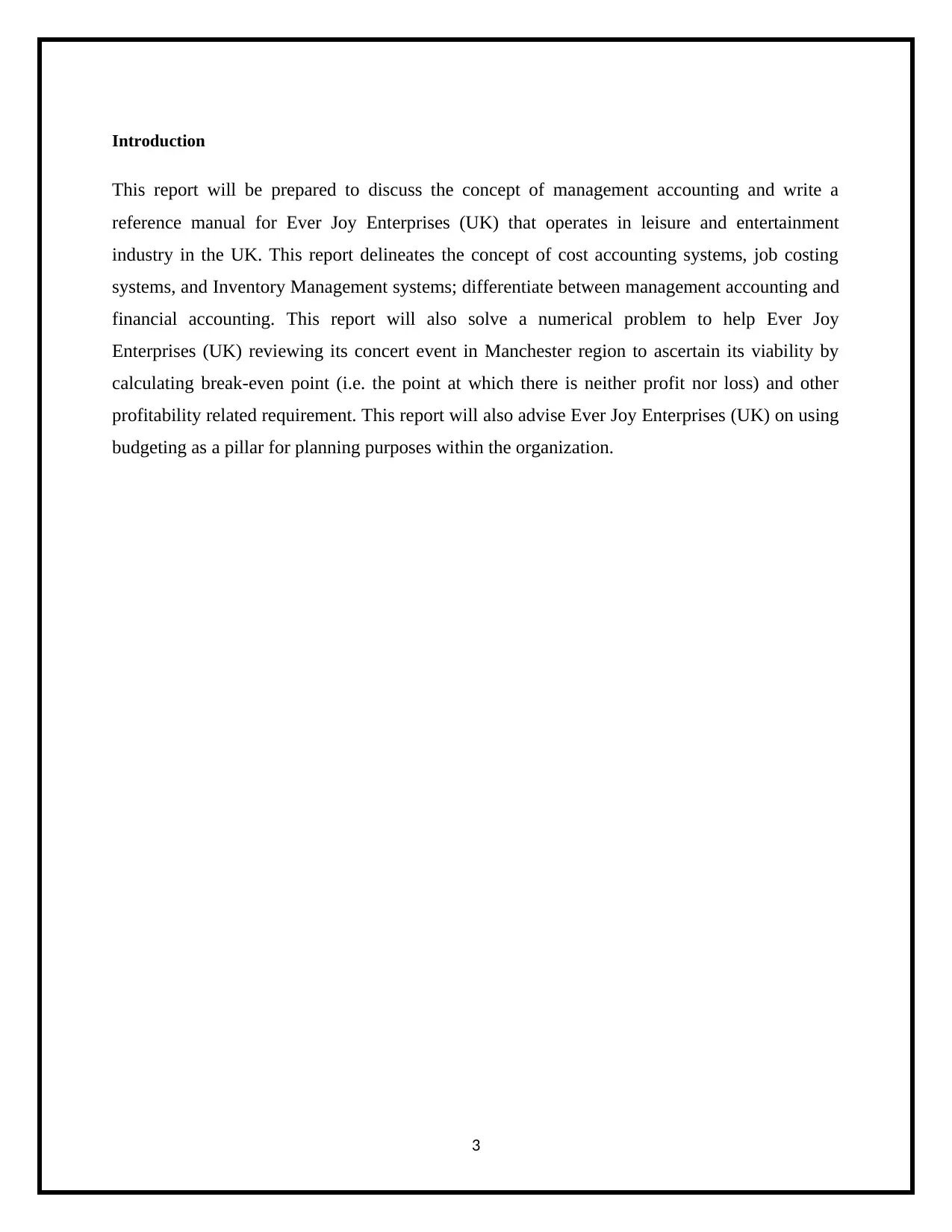
Introduction
This report will be prepared to discuss the concept of management accounting and write a
reference manual for Ever Joy Enterprises (UK) that operates in leisure and entertainment
industry in the UK. This report delineates the concept of cost accounting systems, job costing
systems, and Inventory Management systems; differentiate between management accounting and
financial accounting. This report will also solve a numerical problem to help Ever Joy
Enterprises (UK) reviewing its concert event in Manchester region to ascertain its viability by
calculating break-even point (i.e. the point at which there is neither profit nor loss) and other
profitability related requirement. This report will also advise Ever Joy Enterprises (UK) on using
budgeting as a pillar for planning purposes within the organization.
3
This report will be prepared to discuss the concept of management accounting and write a
reference manual for Ever Joy Enterprises (UK) that operates in leisure and entertainment
industry in the UK. This report delineates the concept of cost accounting systems, job costing
systems, and Inventory Management systems; differentiate between management accounting and
financial accounting. This report will also solve a numerical problem to help Ever Joy
Enterprises (UK) reviewing its concert event in Manchester region to ascertain its viability by
calculating break-even point (i.e. the point at which there is neither profit nor loss) and other
profitability related requirement. This report will also advise Ever Joy Enterprises (UK) on using
budgeting as a pillar for planning purposes within the organization.
3
⊘ This is a preview!⊘
Do you want full access?
Subscribe today to unlock all pages.

Trusted by 1+ million students worldwide
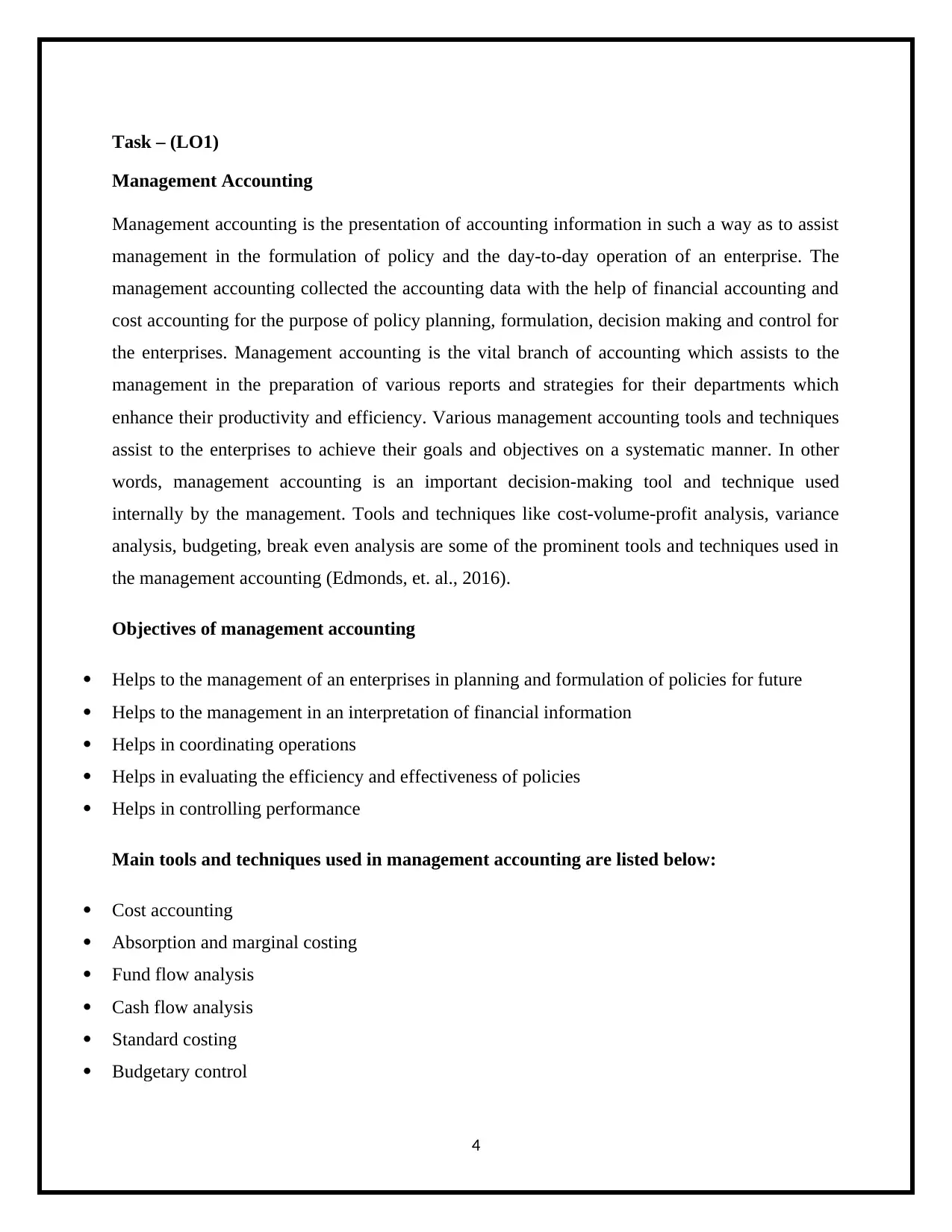
Task – (LO1)
Management Accounting
Management accounting is the presentation of accounting information in such a way as to assist
management in the formulation of policy and the day-to-day operation of an enterprise. The
management accounting collected the accounting data with the help of financial accounting and
cost accounting for the purpose of policy planning, formulation, decision making and control for
the enterprises. Management accounting is the vital branch of accounting which assists to the
management in the preparation of various reports and strategies for their departments which
enhance their productivity and efficiency. Various management accounting tools and techniques
assist to the enterprises to achieve their goals and objectives on a systematic manner. In other
words, management accounting is an important decision-making tool and technique used
internally by the management. Tools and techniques like cost-volume-profit analysis, variance
analysis, budgeting, break even analysis are some of the prominent tools and techniques used in
the management accounting (Edmonds, et. al., 2016).
Objectives of management accounting
Helps to the management of an enterprises in planning and formulation of policies for future
Helps to the management in an interpretation of financial information
Helps in coordinating operations
Helps in evaluating the efficiency and effectiveness of policies
Helps in controlling performance
Main tools and techniques used in management accounting are listed below:
Cost accounting
Absorption and marginal costing
Fund flow analysis
Cash flow analysis
Standard costing
Budgetary control
4
Management Accounting
Management accounting is the presentation of accounting information in such a way as to assist
management in the formulation of policy and the day-to-day operation of an enterprise. The
management accounting collected the accounting data with the help of financial accounting and
cost accounting for the purpose of policy planning, formulation, decision making and control for
the enterprises. Management accounting is the vital branch of accounting which assists to the
management in the preparation of various reports and strategies for their departments which
enhance their productivity and efficiency. Various management accounting tools and techniques
assist to the enterprises to achieve their goals and objectives on a systematic manner. In other
words, management accounting is an important decision-making tool and technique used
internally by the management. Tools and techniques like cost-volume-profit analysis, variance
analysis, budgeting, break even analysis are some of the prominent tools and techniques used in
the management accounting (Edmonds, et. al., 2016).
Objectives of management accounting
Helps to the management of an enterprises in planning and formulation of policies for future
Helps to the management in an interpretation of financial information
Helps in coordinating operations
Helps in evaluating the efficiency and effectiveness of policies
Helps in controlling performance
Main tools and techniques used in management accounting are listed below:
Cost accounting
Absorption and marginal costing
Fund flow analysis
Cash flow analysis
Standard costing
Budgetary control
4
Paraphrase This Document
Need a fresh take? Get an instant paraphrase of this document with our AI Paraphraser
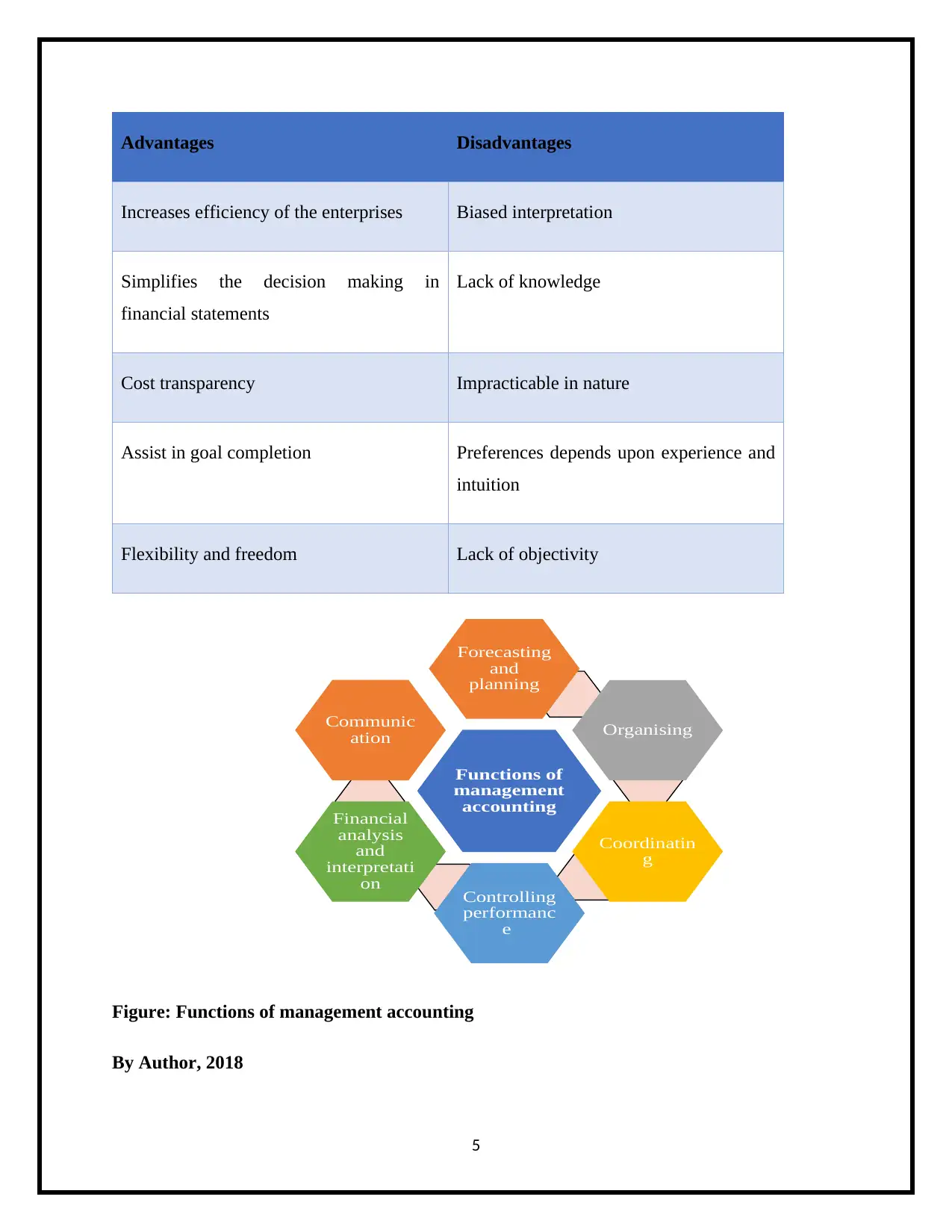
Advantages Disadvantages
Increases efficiency of the enterprises Biased interpretation
Simplifies the decision making in
financial statements
Lack of knowledge
Cost transparency Impracticable in nature
Assist in goal completion Preferences depends upon experience and
intuition
Flexibility and freedom Lack of objectivity
Figure: Functions of management accounting
By Author, 2018
5
Functions of
management
accounting
Forecasting
and
planning
Organising
Coordinatin
g
Controlling
performanc
e
Financial
analysis
and
interpretati
on
Communic
ation
Increases efficiency of the enterprises Biased interpretation
Simplifies the decision making in
financial statements
Lack of knowledge
Cost transparency Impracticable in nature
Assist in goal completion Preferences depends upon experience and
intuition
Flexibility and freedom Lack of objectivity
Figure: Functions of management accounting
By Author, 2018
5
Functions of
management
accounting
Forecasting
and
planning
Organising
Coordinatin
g
Controlling
performanc
e
Financial
analysis
and
interpretati
on
Communic
ation
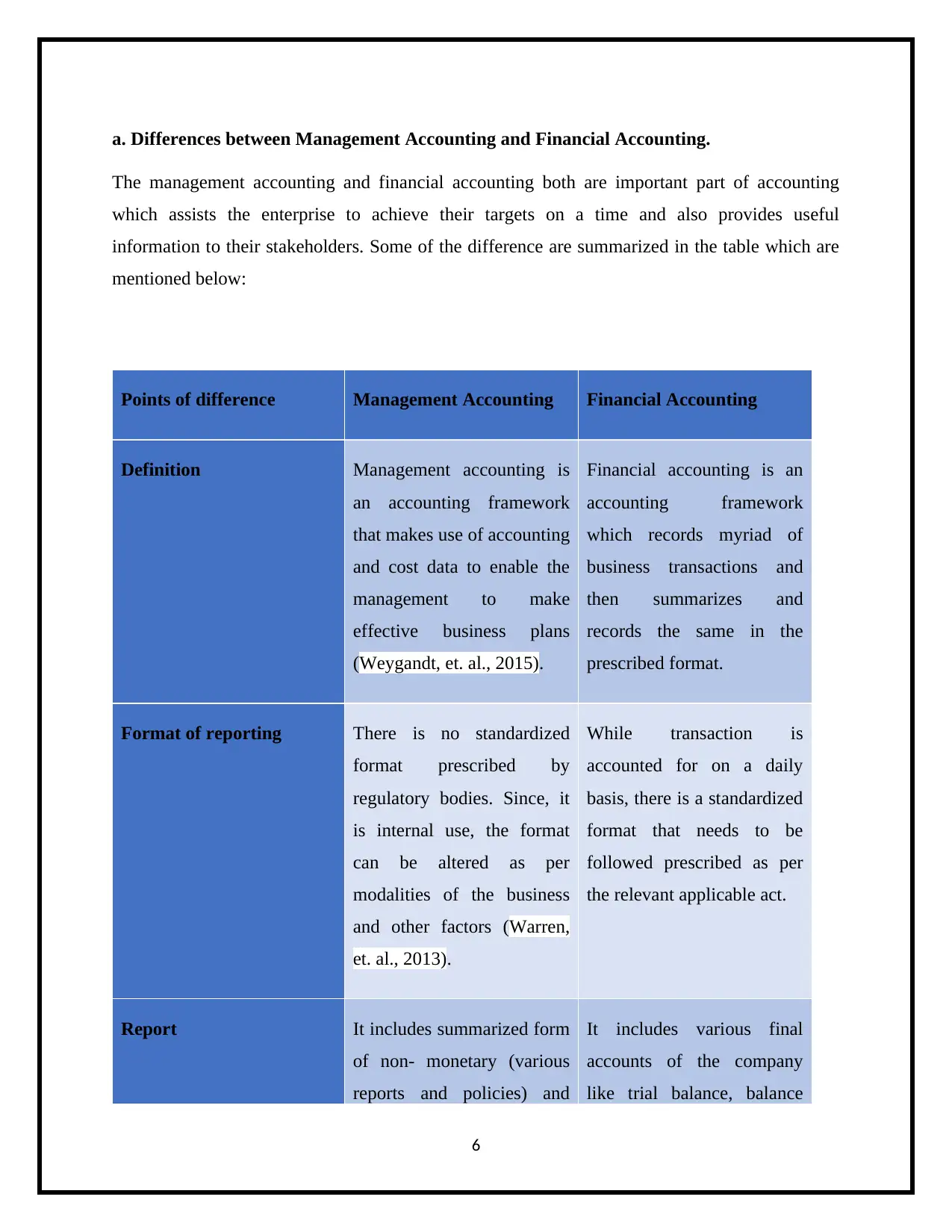
a. Differences between Management Accounting and Financial Accounting.
The management accounting and financial accounting both are important part of accounting
which assists the enterprise to achieve their targets on a time and also provides useful
information to their stakeholders. Some of the difference are summarized in the table which are
mentioned below:
Points of difference Management Accounting Financial Accounting
Definition Management accounting is
an accounting framework
that makes use of accounting
and cost data to enable the
management to make
effective business plans
(Weygandt, et. al., 2015).
Financial accounting is an
accounting framework
which records myriad of
business transactions and
then summarizes and
records the same in the
prescribed format.
Format of reporting There is no standardized
format prescribed by
regulatory bodies. Since, it
is internal use, the format
can be altered as per
modalities of the business
and other factors (Warren,
et. al., 2013).
While transaction is
accounted for on a daily
basis, there is a standardized
format that needs to be
followed prescribed as per
the relevant applicable act.
Report It includes summarized form
of non- monetary (various
reports and policies) and
It includes various final
accounts of the company
like trial balance, balance
6
The management accounting and financial accounting both are important part of accounting
which assists the enterprise to achieve their targets on a time and also provides useful
information to their stakeholders. Some of the difference are summarized in the table which are
mentioned below:
Points of difference Management Accounting Financial Accounting
Definition Management accounting is
an accounting framework
that makes use of accounting
and cost data to enable the
management to make
effective business plans
(Weygandt, et. al., 2015).
Financial accounting is an
accounting framework
which records myriad of
business transactions and
then summarizes and
records the same in the
prescribed format.
Format of reporting There is no standardized
format prescribed by
regulatory bodies. Since, it
is internal use, the format
can be altered as per
modalities of the business
and other factors (Warren,
et. al., 2013).
While transaction is
accounted for on a daily
basis, there is a standardized
format that needs to be
followed prescribed as per
the relevant applicable act.
Report It includes summarized form
of non- monetary (various
reports and policies) and
It includes various final
accounts of the company
like trial balance, balance
6
⊘ This is a preview!⊘
Do you want full access?
Subscribe today to unlock all pages.

Trusted by 1+ million students worldwide
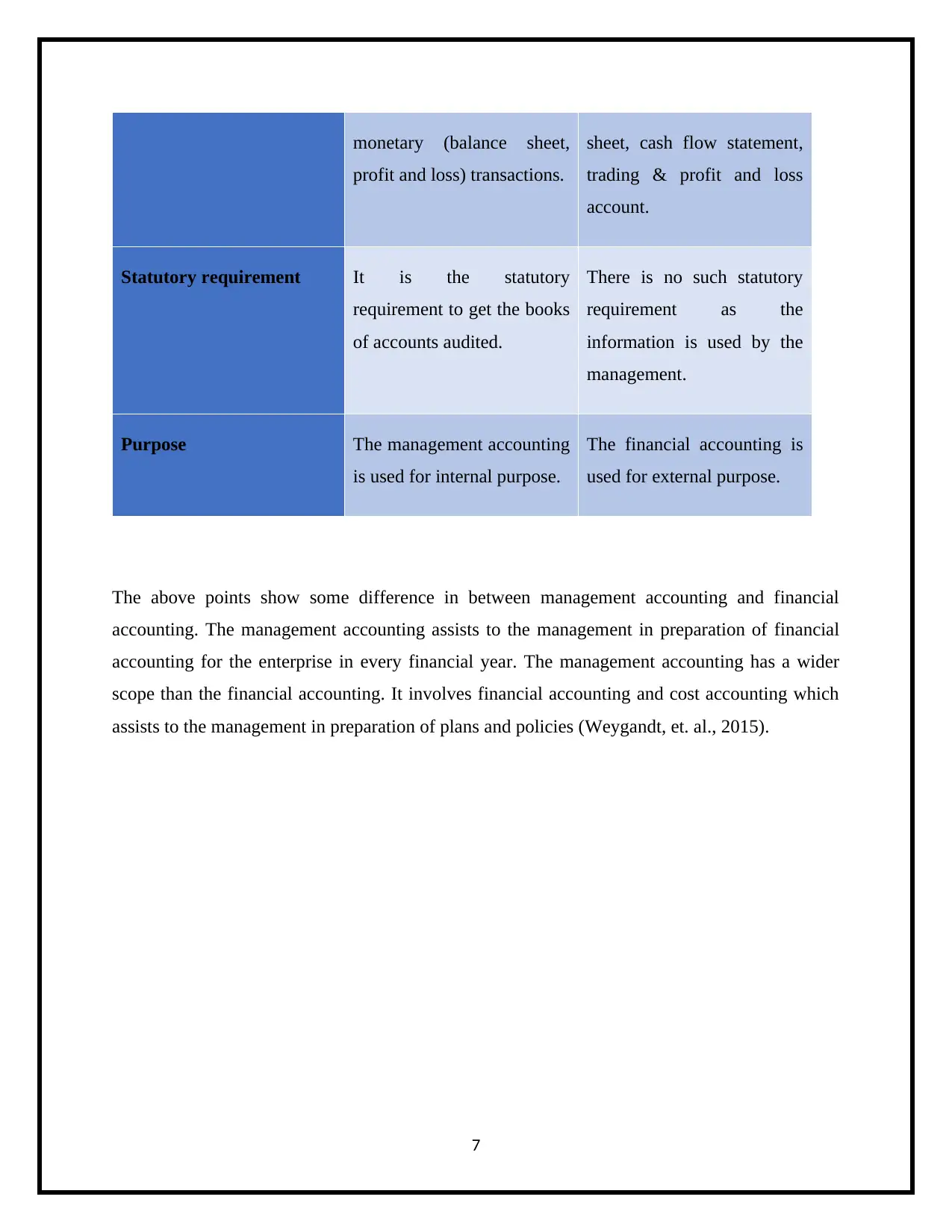
monetary (balance sheet,
profit and loss) transactions.
sheet, cash flow statement,
trading & profit and loss
account.
Statutory requirement It is the statutory
requirement to get the books
of accounts audited.
There is no such statutory
requirement as the
information is used by the
management.
Purpose The management accounting
is used for internal purpose.
The financial accounting is
used for external purpose.
The above points show some difference in between management accounting and financial
accounting. The management accounting assists to the management in preparation of financial
accounting for the enterprise in every financial year. The management accounting has a wider
scope than the financial accounting. It involves financial accounting and cost accounting which
assists to the management in preparation of plans and policies (Weygandt, et. al., 2015).
7
profit and loss) transactions.
sheet, cash flow statement,
trading & profit and loss
account.
Statutory requirement It is the statutory
requirement to get the books
of accounts audited.
There is no such statutory
requirement as the
information is used by the
management.
Purpose The management accounting
is used for internal purpose.
The financial accounting is
used for external purpose.
The above points show some difference in between management accounting and financial
accounting. The management accounting assists to the management in preparation of financial
accounting for the enterprise in every financial year. The management accounting has a wider
scope than the financial accounting. It involves financial accounting and cost accounting which
assists to the management in preparation of plans and policies (Weygandt, et. al., 2015).
7
Paraphrase This Document
Need a fresh take? Get an instant paraphrase of this document with our AI Paraphraser
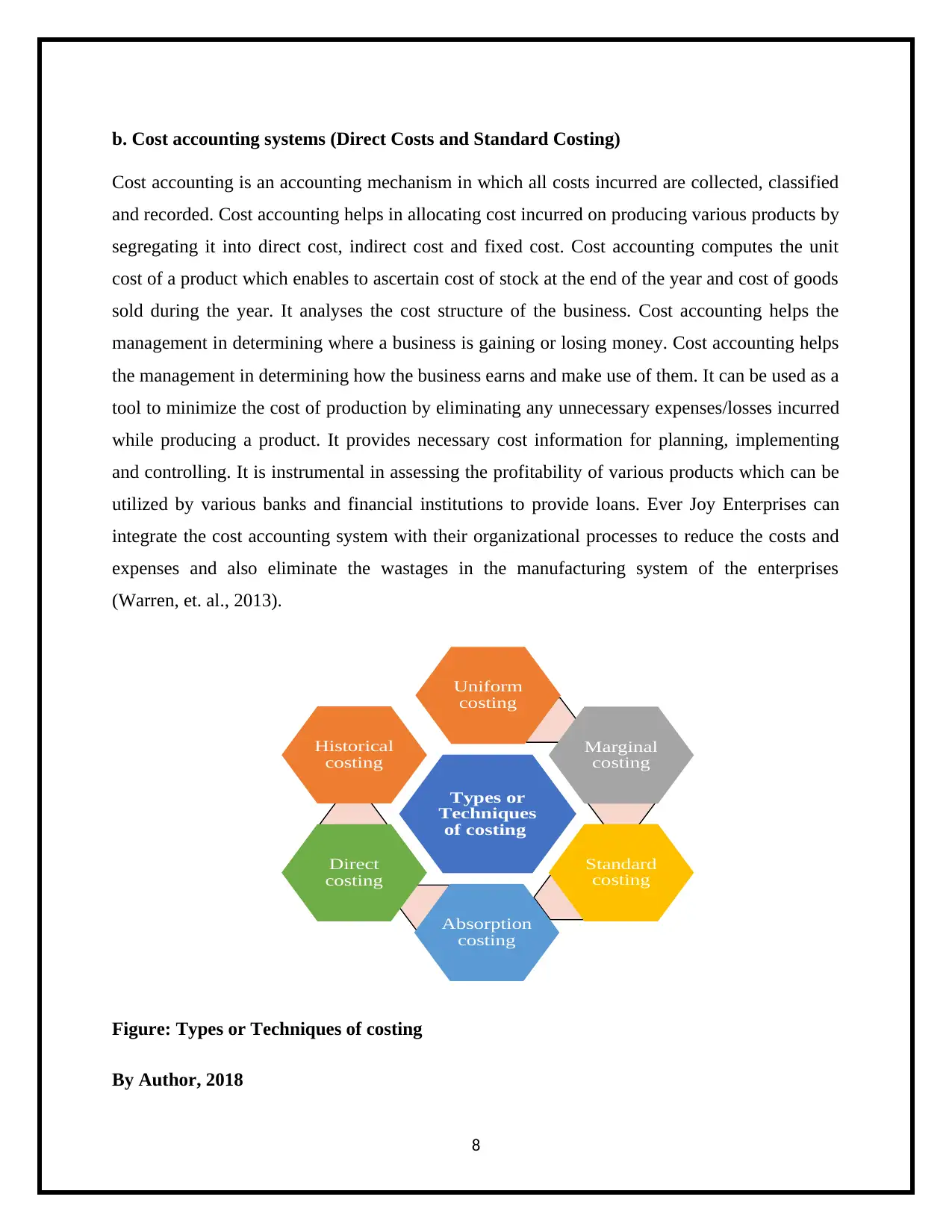
b. Cost accounting systems (Direct Costs and Standard Costing)
Cost accounting is an accounting mechanism in which all costs incurred are collected, classified
and recorded. Cost accounting helps in allocating cost incurred on producing various products by
segregating it into direct cost, indirect cost and fixed cost. Cost accounting computes the unit
cost of a product which enables to ascertain cost of stock at the end of the year and cost of goods
sold during the year. It analyses the cost structure of the business. Cost accounting helps the
management in determining where a business is gaining or losing money. Cost accounting helps
the management in determining how the business earns and make use of them. It can be used as a
tool to minimize the cost of production by eliminating any unnecessary expenses/losses incurred
while producing a product. It provides necessary cost information for planning, implementing
and controlling. It is instrumental in assessing the profitability of various products which can be
utilized by various banks and financial institutions to provide loans. Ever Joy Enterprises can
integrate the cost accounting system with their organizational processes to reduce the costs and
expenses and also eliminate the wastages in the manufacturing system of the enterprises
(Warren, et. al., 2013).
Figure: Types or Techniques of costing
By Author, 2018
8
Types or
Techniques
of costing
Uniform
costing
Marginal
costing
Standard
costing
Absorption
costing
Direct
costing
Historical
costing
Cost accounting is an accounting mechanism in which all costs incurred are collected, classified
and recorded. Cost accounting helps in allocating cost incurred on producing various products by
segregating it into direct cost, indirect cost and fixed cost. Cost accounting computes the unit
cost of a product which enables to ascertain cost of stock at the end of the year and cost of goods
sold during the year. It analyses the cost structure of the business. Cost accounting helps the
management in determining where a business is gaining or losing money. Cost accounting helps
the management in determining how the business earns and make use of them. It can be used as a
tool to minimize the cost of production by eliminating any unnecessary expenses/losses incurred
while producing a product. It provides necessary cost information for planning, implementing
and controlling. It is instrumental in assessing the profitability of various products which can be
utilized by various banks and financial institutions to provide loans. Ever Joy Enterprises can
integrate the cost accounting system with their organizational processes to reduce the costs and
expenses and also eliminate the wastages in the manufacturing system of the enterprises
(Warren, et. al., 2013).
Figure: Types or Techniques of costing
By Author, 2018
8
Types or
Techniques
of costing
Uniform
costing
Marginal
costing
Standard
costing
Absorption
costing
Direct
costing
Historical
costing
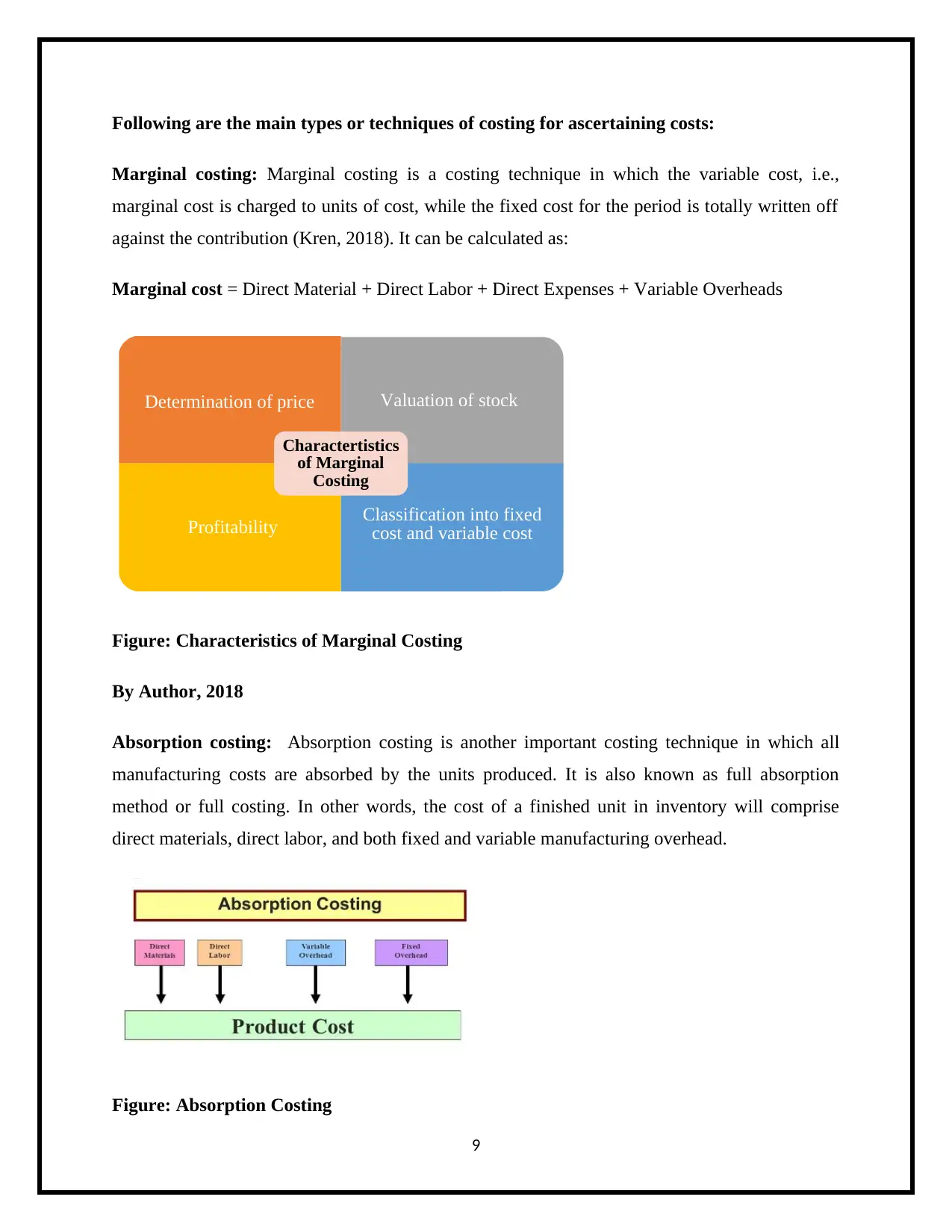
Following are the main types or techniques of costing for ascertaining costs:
Marginal costing: Marginal costing is a costing technique in which the variable cost, i.e.,
marginal cost is charged to units of cost, while the fixed cost for the period is totally written off
against the contribution (Kren, 2018). It can be calculated as:
Marginal cost = Direct Material + Direct Labor + Direct Expenses + Variable Overheads
Figure: Characteristics of Marginal Costing
By Author, 2018
Absorption costing: Absorption costing is another important costing technique in which all
manufacturing costs are absorbed by the units produced. It is also known as full absorption
method or full costing. In other words, the cost of a finished unit in inventory will comprise
direct materials, direct labor, and both fixed and variable manufacturing overhead.
Figure: Absorption Costing
9
Determination of price Valuation of stock
Profitability Classification into fixed
cost and variable cost
Charactertistics
of Marginal
Costing
Marginal costing: Marginal costing is a costing technique in which the variable cost, i.e.,
marginal cost is charged to units of cost, while the fixed cost for the period is totally written off
against the contribution (Kren, 2018). It can be calculated as:
Marginal cost = Direct Material + Direct Labor + Direct Expenses + Variable Overheads
Figure: Characteristics of Marginal Costing
By Author, 2018
Absorption costing: Absorption costing is another important costing technique in which all
manufacturing costs are absorbed by the units produced. It is also known as full absorption
method or full costing. In other words, the cost of a finished unit in inventory will comprise
direct materials, direct labor, and both fixed and variable manufacturing overhead.
Figure: Absorption Costing
9
Determination of price Valuation of stock
Profitability Classification into fixed
cost and variable cost
Charactertistics
of Marginal
Costing
⊘ This is a preview!⊘
Do you want full access?
Subscribe today to unlock all pages.

Trusted by 1+ million students worldwide
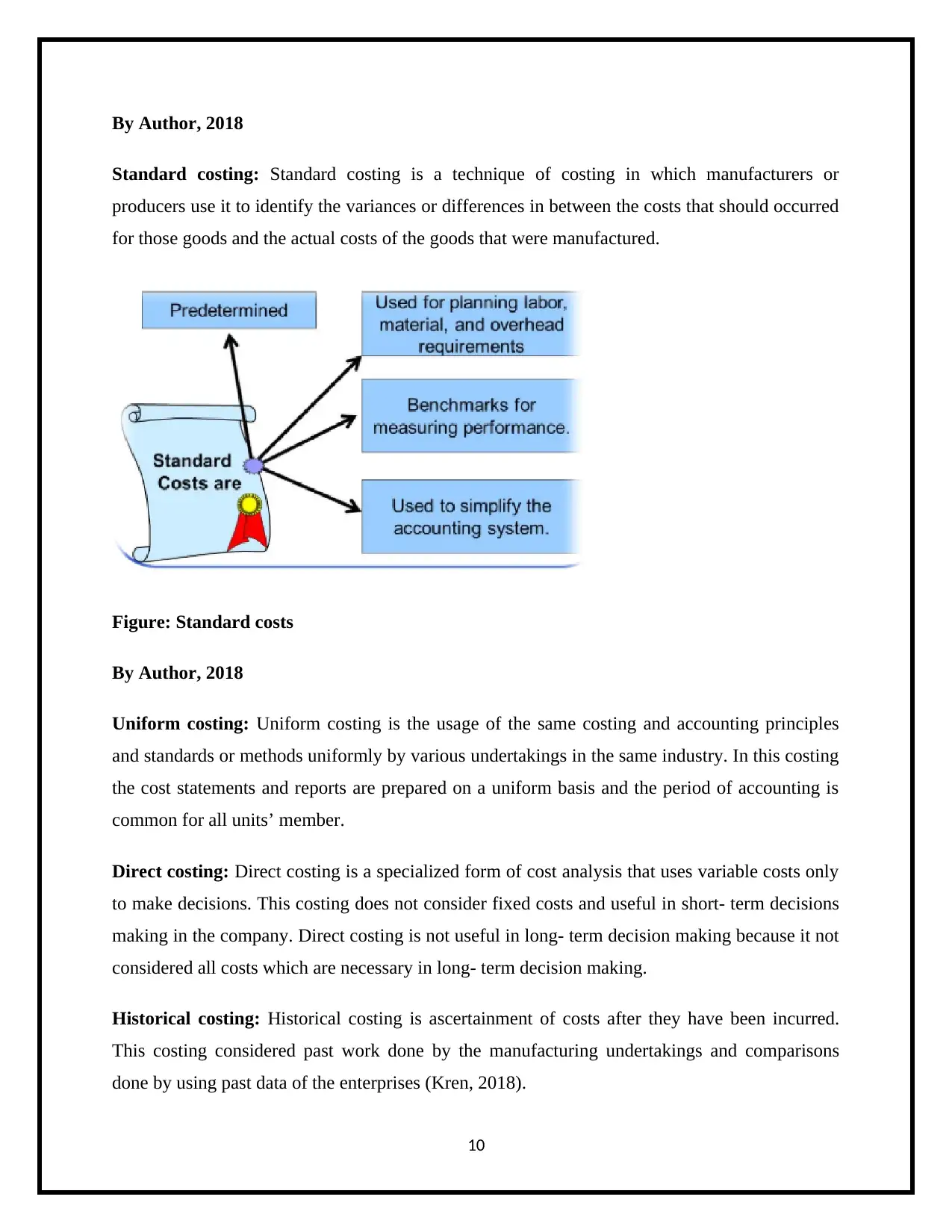
By Author, 2018
Standard costing: Standard costing is a technique of costing in which manufacturers or
producers use it to identify the variances or differences in between the costs that should occurred
for those goods and the actual costs of the goods that were manufactured.
Figure: Standard costs
By Author, 2018
Uniform costing: Uniform costing is the usage of the same costing and accounting principles
and standards or methods uniformly by various undertakings in the same industry. In this costing
the cost statements and reports are prepared on a uniform basis and the period of accounting is
common for all units’ member.
Direct costing: Direct costing is a specialized form of cost analysis that uses variable costs only
to make decisions. This costing does not consider fixed costs and useful in short- term decisions
making in the company. Direct costing is not useful in long- term decision making because it not
considered all costs which are necessary in long- term decision making.
Historical costing: Historical costing is ascertainment of costs after they have been incurred.
This costing considered past work done by the manufacturing undertakings and comparisons
done by using past data of the enterprises (Kren, 2018).
10
Standard costing: Standard costing is a technique of costing in which manufacturers or
producers use it to identify the variances or differences in between the costs that should occurred
for those goods and the actual costs of the goods that were manufactured.
Figure: Standard costs
By Author, 2018
Uniform costing: Uniform costing is the usage of the same costing and accounting principles
and standards or methods uniformly by various undertakings in the same industry. In this costing
the cost statements and reports are prepared on a uniform basis and the period of accounting is
common for all units’ member.
Direct costing: Direct costing is a specialized form of cost analysis that uses variable costs only
to make decisions. This costing does not consider fixed costs and useful in short- term decisions
making in the company. Direct costing is not useful in long- term decision making because it not
considered all costs which are necessary in long- term decision making.
Historical costing: Historical costing is ascertainment of costs after they have been incurred.
This costing considered past work done by the manufacturing undertakings and comparisons
done by using past data of the enterprises (Kren, 2018).
10
Paraphrase This Document
Need a fresh take? Get an instant paraphrase of this document with our AI Paraphraser
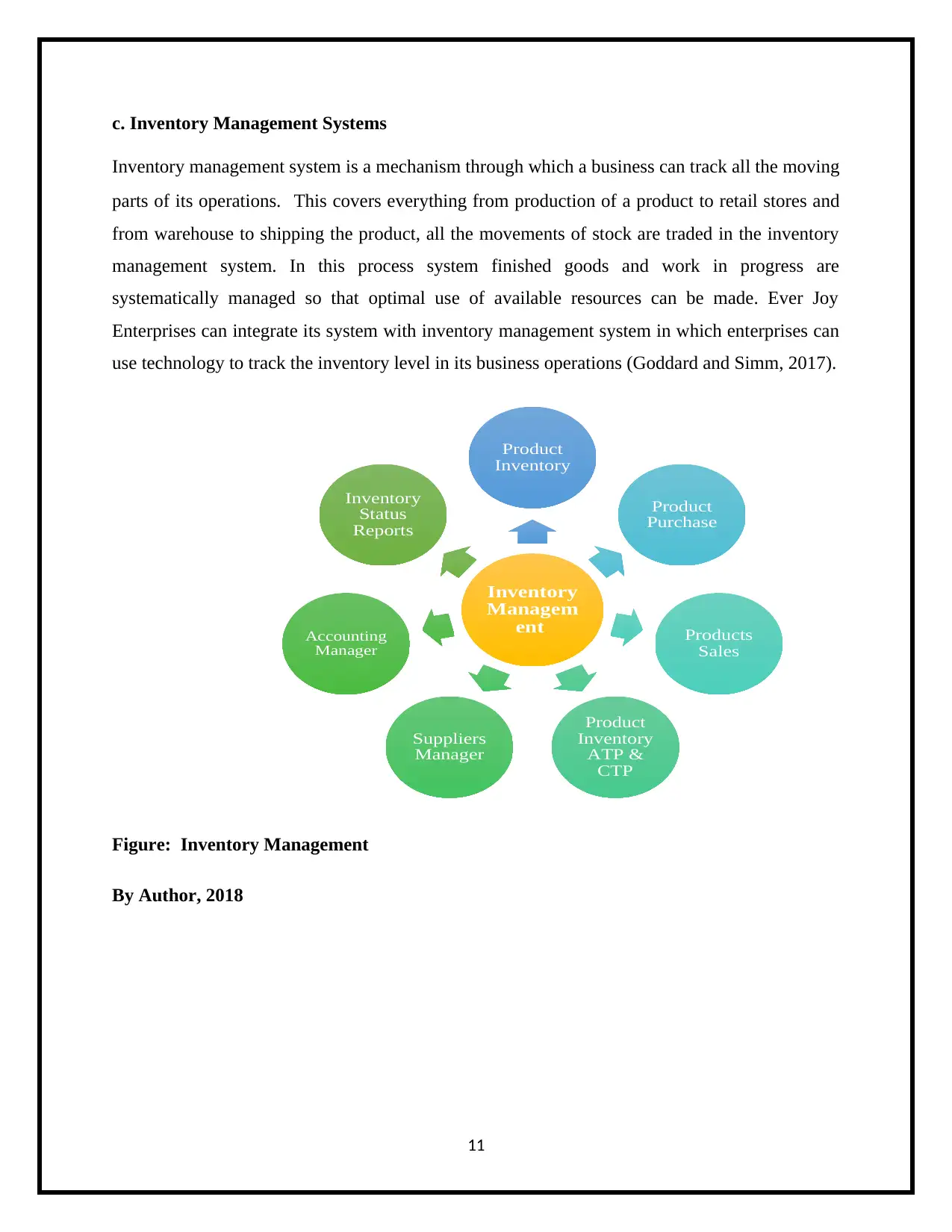
c. Inventory Management Systems
Inventory management system is a mechanism through which a business can track all the moving
parts of its operations. This covers everything from production of a product to retail stores and
from warehouse to shipping the product, all the movements of stock are traded in the inventory
management system. In this process system finished goods and work in progress are
systematically managed so that optimal use of available resources can be made. Ever Joy
Enterprises can integrate its system with inventory management system in which enterprises can
use technology to track the inventory level in its business operations (Goddard and Simm, 2017).
Figure: Inventory Management
By Author, 2018
11
Inventory
Managem
ent
Product
Inventory
Product
Purchase
Products
Sales
Product
Inventory
ATP &
CTP
Suppliers
Manager
Accounting
Manager
Inventory
Status
Reports
Inventory management system is a mechanism through which a business can track all the moving
parts of its operations. This covers everything from production of a product to retail stores and
from warehouse to shipping the product, all the movements of stock are traded in the inventory
management system. In this process system finished goods and work in progress are
systematically managed so that optimal use of available resources can be made. Ever Joy
Enterprises can integrate its system with inventory management system in which enterprises can
use technology to track the inventory level in its business operations (Goddard and Simm, 2017).
Figure: Inventory Management
By Author, 2018
11
Inventory
Managem
ent
Product
Inventory
Product
Purchase
Products
Sales
Product
Inventory
ATP &
CTP
Suppliers
Manager
Accounting
Manager
Inventory
Status
Reports
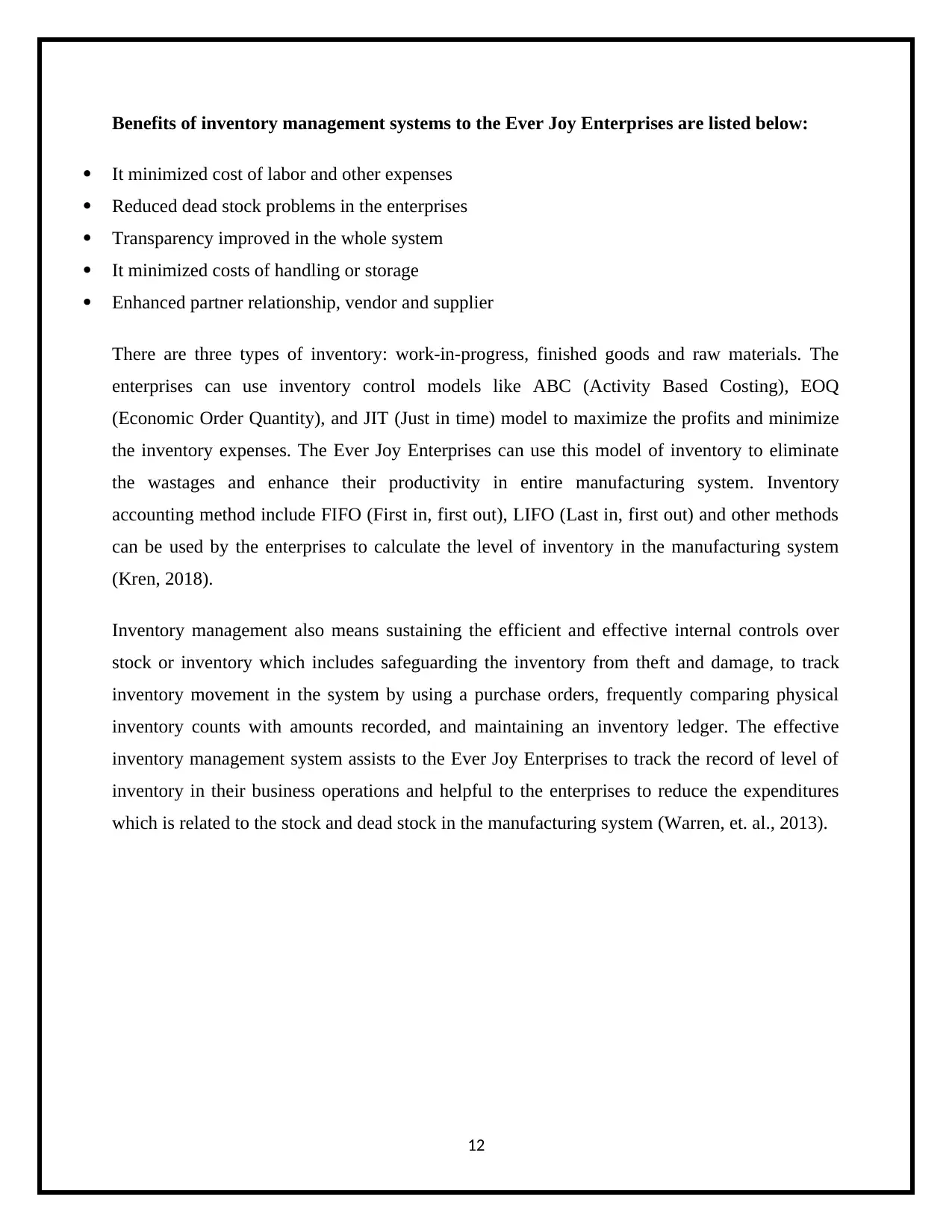
Benefits of inventory management systems to the Ever Joy Enterprises are listed below:
It minimized cost of labor and other expenses
Reduced dead stock problems in the enterprises
Transparency improved in the whole system
It minimized costs of handling or storage
Enhanced partner relationship, vendor and supplier
There are three types of inventory: work-in-progress, finished goods and raw materials. The
enterprises can use inventory control models like ABC (Activity Based Costing), EOQ
(Economic Order Quantity), and JIT (Just in time) model to maximize the profits and minimize
the inventory expenses. The Ever Joy Enterprises can use this model of inventory to eliminate
the wastages and enhance their productivity in entire manufacturing system. Inventory
accounting method include FIFO (First in, first out), LIFO (Last in, first out) and other methods
can be used by the enterprises to calculate the level of inventory in the manufacturing system
(Kren, 2018).
Inventory management also means sustaining the efficient and effective internal controls over
stock or inventory which includes safeguarding the inventory from theft and damage, to track
inventory movement in the system by using a purchase orders, frequently comparing physical
inventory counts with amounts recorded, and maintaining an inventory ledger. The effective
inventory management system assists to the Ever Joy Enterprises to track the record of level of
inventory in their business operations and helpful to the enterprises to reduce the expenditures
which is related to the stock and dead stock in the manufacturing system (Warren, et. al., 2013).
12
It minimized cost of labor and other expenses
Reduced dead stock problems in the enterprises
Transparency improved in the whole system
It minimized costs of handling or storage
Enhanced partner relationship, vendor and supplier
There are three types of inventory: work-in-progress, finished goods and raw materials. The
enterprises can use inventory control models like ABC (Activity Based Costing), EOQ
(Economic Order Quantity), and JIT (Just in time) model to maximize the profits and minimize
the inventory expenses. The Ever Joy Enterprises can use this model of inventory to eliminate
the wastages and enhance their productivity in entire manufacturing system. Inventory
accounting method include FIFO (First in, first out), LIFO (Last in, first out) and other methods
can be used by the enterprises to calculate the level of inventory in the manufacturing system
(Kren, 2018).
Inventory management also means sustaining the efficient and effective internal controls over
stock or inventory which includes safeguarding the inventory from theft and damage, to track
inventory movement in the system by using a purchase orders, frequently comparing physical
inventory counts with amounts recorded, and maintaining an inventory ledger. The effective
inventory management system assists to the Ever Joy Enterprises to track the record of level of
inventory in their business operations and helpful to the enterprises to reduce the expenditures
which is related to the stock and dead stock in the manufacturing system (Warren, et. al., 2013).
12
⊘ This is a preview!⊘
Do you want full access?
Subscribe today to unlock all pages.

Trusted by 1+ million students worldwide
1 out of 32
Related Documents
Your All-in-One AI-Powered Toolkit for Academic Success.
+13062052269
info@desklib.com
Available 24*7 on WhatsApp / Email
![[object Object]](/_next/static/media/star-bottom.7253800d.svg)
Unlock your academic potential
Copyright © 2020–2025 A2Z Services. All Rights Reserved. Developed and managed by ZUCOL.





